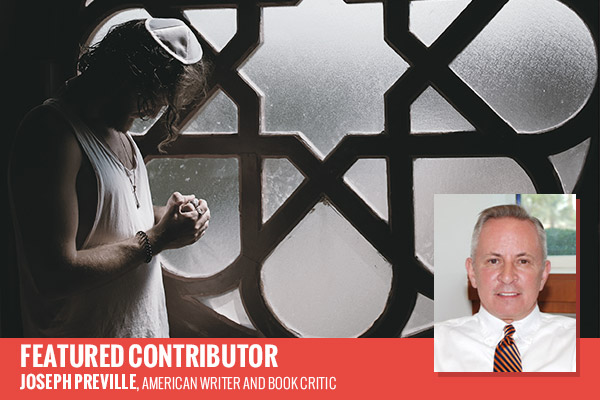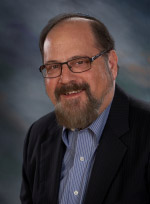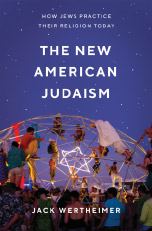
New American Judaism: How American Jews are Breathing New Life into Their Communities [Interview]
- By Joseph Preville --
- 20 Sep 2018 --

American Jews are now far more inclined to approach Jewish religious practice selectively and idiosyncratically.
How are American Jews breathing new life and vitality into their religious communities? And, how are they creating innovative and unconventional paths to spiritual fulfillment within Judaism? Distinguished historian Jack Wertheimer considers these questions in his superb new book, The New American Judaism: How Jews Practice Their Religion Today (Princeton University Press, 2018). Wertheimer’s book is based on his comprehensive national survey of Jews from all religious traditions and movements. “Why,” Wertheimer asks, “write a book about American Judaism? Because aside from anti-Semitic persecution, nothing is likely to play a larger role in determining the future of Jewish life in this country than the lived religion of ordinary Jews.”

‘New American Judaism’: How American Jews are Breathing New Life into Their Communities [Interview][/tweetthis]
Jack Wertheimer discusses his new book in this interview.
Joseph Richard Preville: Why is it important to study and write about the religious lives of ordinary American Jews?
Jack Wertheimer: It’s important to study “average” Jews for the same reason that we have to pay more attention to “average” Americans and not just the elites. I should hope that the 2016 presidential election served as a wake-up call. So much writing about American politics failed to understand, let alone anticipate, what transpired because the so-called “fly-over” country was ignored and the coasts where elite culture predominates were assumed to be somehow representative. Elites have a role to play but they overestimate their influence.
Religious elites have their own vocabulary and understanding of what is important. They offer a structure and a coherent approach to religion. Average people, though, abide by a folk religion only partially based on elite conceptions. That is true in Judaism, and also in other religions.
In our current age of hyper-individualism and Do-It-Yourself religion, American Jews, much like their Christian neighbors, are far more inclined than in the past to approach Jewish religious practice selectively and idiosyncratically. An account of American Judaism today, therefore, must focus on the unconventional, as well as the conventional, if it wishes to capture the lived Judaism, as opposed to relying solely on official pronouncements.
As to why it’s important to write about the religious lives of American Jews, rather than other dimensions—such as politics, demography, cultural productivity or philanthropy—I’m convinced that aside from anti-Semitism, nothing will determine the future of American Jewish life in this country more than their religious involvements. Many Jews, of course, define themselves as secular. I most certainly do not read them out of Jewish life. But I have my doubts whether secular Jewish identity can be transmitted from generation to generation, especially because most Jews are highly integrated into American society.
JRP: You interviewed 160 rabbis from diverse Jewish communities across the United States for your book. What surprised you the most about those interviews?
JW:Having devoted decades to studying American Jewish life, I can’t say I was surprised, so much as moved and inspired by what I learned. Listening to rabbis and other synagogue officiants describe their enormous investment of time and energy to reshape worship services so as to make them accessible to all comers impressed upon me just how dynamic many religions institutions continue to be. The rethinking of how to use music, spatial configurations, choreography, content and messaging is a widespread phenomenon in hundreds of synagogues and other places of religions gathering. (The same approach is evident in many churches.)
I’m also moved by the massive efforts of some Orthodox groups to reach out to their less observant co-religionists. The scale of this effort and the sheer numbers of Jews touched by Orthodox outreach centers could not have been anticipated even two decades ago. It’s remarkable to observe Jews quite removed from traditional lives who are willing to give tradition a second look. Unlike mid-twentieth century Jews who distanced themselves from religious traditionalism fearing it was un-American or a throw-back to the Old World, the grandchildren of such Jews are currently far more willing to try out some aspects of traditional religion. I deeply admire the Orthodox Jews who invest themselves in the effort. Their involvement bespeaks a resolve to resist what others see as the inevitable triumph of secularization and assimilation. They figuratively light candles, rather than curse at darkness and bleak prognostications.
Still a third fascinating development is the renewal taking place in what I call unconventional settings for religious congregating. At a time of much hand-wringing about the drift of Gen X and Millennials away from Jewish life, these places are gearing their efforts to attract otherwise unengaged Jews to some kind of religious programming. Most leaders of these efforts are part of the same age cohorts, and they are deeply invested in their own forms of outreach.
Collectively, these three nodes of renewal offer reason for hope that more American Jews can be inspired to return to their religious traditions—or at least to some.
JRP: Where and when do you think the majority of American Jews feels the most connected to their faith and community?

Unfortunately, these gatherings seem to occur with less frequency than in the past, so that rituals of Judaism are celebrated as very “sometime” things. Increasingly too, Judaism is relegated to the synagogue, with fewer Jews holding a Passover seder at home but relying instead on one offered in their synagogue. The spheres where Jews enact their Judaism are decreasing in number, and that means religion plays a diminished and far more circumscribed role in their lives.
JRP: Why are religious start-ups flourishing, and how are they inspiring American Jewish communities to become more inclusive, responsive, and innovative?
JW:In this case, I would define “flourishing” as spreading. We don’t yet know about the staying power of religious start-ups. Existing on the margins, these start-ups have the luxury to experiment: some dispense with rabbis and make decisions in a democratic fashion; others shorten religious services, and invite participants to express themselves by reading their own poetic writings or performing music of their own composition; still others target specific sub-populations by offering healing services or incorporating meditation practices; many meet in unconventional settings such as bars. Conventional synagogues are not oblivious of these efforts. Some adopt approaches to worship pioneered in unconventional settings. Contrary to the mythology about synagogues being staid, unchanging places, conventional congregations in the past have introduced music, ways of organizing, and practices pioneered by those on the margins. We are witnessing the same phenomenon today.
JRP: What is “Golden Rule Judaism” and how does it shape the lives and experiences of ordinary Jews?
JW:Sociologist Nancy Ammerman has written about Christians whose religion is primarily defined by a desire to adhere to the “Golden Rule.” A wide swathe of Jews similarly regards not only the essence of their religion, but its totality as solely a matter of behaving like a “good person.” This approach was noted already in the early 1960s by Marshall Sklare and Joseph Greenblum who wrote about the shift from “sacramentalism to moralism.” Judaism was no longer understood as a set of sacred acts, rituals and commandments; rather it was all about doing the right thing.
In some instances, identifying proper ethical behavior is straightforward—as in the case of the Ten Commandments, which prohibit murder and stealing. We humans face many circumstances, though, where the right thing to do is not so clear-cut. Is forbidding citizens to own guns always the best policy? Should there be any limits on a woman’s choice to abort a pregnancy? Should we admit all refugees in danger of life and limb wishing to enter our country? These current hot button issues are not so easily answered. Or on a more mundane level, how are we to respond when we witness misbehavior? Jewish texts provide some guidance to address such hard questions. But most Jews tend not to bother with them, preferring instead to be guided by the mores of their environment.
In this light, I would rephrase the question. Golden Rule Judaism is not reshaping the lives of ordinary Jews; the larger culture is, and in the process that culture is also reshaping, and in my view distorting, Jewish religious teachings. Golden Rule Judaism internalizes a particular version of American culture, and ignores what Jewish texts have to say about the real-life dilemmas we all face.
JRP: Do you think Israel will remain a significant concern and passion for American Jews in the future?
JW:At present, Israel continues to be a passion, as you put it, of American Jews. The proof is to be found in the fact that in some corners of the community, strongly held views about Israeli government policies spark heated debates. Those are symptoms of passion, not indifference.
I expect passions to run strong among those who feel a connection to the Jewish people, a central pillar of Judaism. Unlike the universal aspirations of Christianity and Islam, Judaism is directed toward a particular people (though, converts are welcome). As a result, the vitality of the Jewish people is a precondition for the fulfillment of Judaism. Indifference to the condition of Jews, whether near or far, is not an option for committed Jews. As the home of the largest concentration of Jews in the world, Israel will remain a lodestar for Jews, especially those with strong religious commitments. For the most part, those who are drifting toward indifference to Israel, who have no interest in visiting Israel with some frequency, who pay no attention to news about Israel, such Jews are also becoming indifferent to Jewish life and religion in general.
Why do those who do attend #Jewish services with some regularity bother to come to #synagogue? Find out in #TheNewAmericanJudaism: https://t.co/g25TFCmmHw
— Princeton University Press (@PrincetonUPress) September 19, 2018
JRP: Why do you think synagogues are “irreplaceable institutions” for the future of Judaism?
JW:Synagogues date back to antiquity as places of public prayer, houses of study and the setting for assembly. These three functions are central to the perpetuation of Judaism, especially in places where Jews constitute a minority. Like their neighbors who gather in churches or mosques, Jews need a place to congregate.
Perhaps I lack the imagination to conceive of a different institution capable of assuming the roles played by synagogues. As I scan the horizon, I don’t see alternatives. True, some Jews are drawn to start-ups in unconventional settings—rented bars, clubs, performing arts spaces or lofts—but these tend to be temporary quarters housing episodic gatherings. Even some of the more experimental on-going religious start-ups find that the greater their success, the more they need to move into more permanent quarters. This is not to say that synagogues are unchanging or that their architecture and programming are static features. But the synagogue has been a durable institution, and is likely to remain one.
JRP: Could you recommend a few classic books or studies on American Jewish communal life and culture?
JW:For a broad sweeping narrative about the development of American Judaism, Jonathan Sarna’s American Judaism: A History (Yale University Press, 2004) is already a classic. Perhaps the most influential book of the past two decades is The Jew Within: Self, Community and Family in America (Indiana University Press, 2000) by Arnold Eisen and Steven M. Cohen. Jewish Identity on the Suburban Frontier: A Study in Group Survival in the Open Society (Basic Books, 1967) by Marshall Sklare and Joseph Greenblum is a pioneering study to which I continually return even though it appeared in the 1960s. And Charles S. Liebman’s The Ambivalent American Jew: Politics, Religion and Family in American Jewish Life (Jewish Publication Society of America, 1973) remains a trenchant analysis, despite having been published forty-five years ago. Although he wrote fiction and had his own ambivalent relationship with Jewish communal life, Philip Roth penned some of the most remarkably insightful depictions of American Jews and their dilemmas, and certainly what is known in Yiddish as their meshugas, or nuttiness.


















